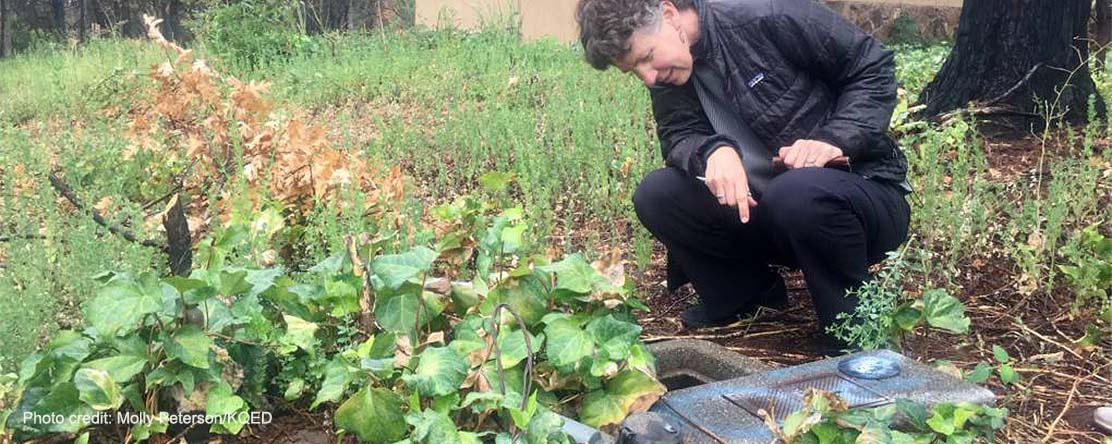
In the News
Paradise Residents Still Can’t Drink the Water
-
Focus Areas
Environmental Health

Since last November, when the Camp Fire almost completely destroyed the town of Paradise, the cancer-causing chemical benzene has tainted the town’s water, leaving it undrinkable. Now an independent team of scientists will begin testing for the carcinogen and other pollutants inside the houses that the fire left standing.
“The main goal is to really understand what’s going on, basically, and to address any issues that come up,” environmental health investigator Dr. Gina Solomon told residents at a recent Paradise Irrigation District meeting.
Ten months after the Camp Fire, the irrigation district still warns residents not to use its water for brushing teeth, making ice, cooking and drinking.
Some residents have purchased tanks at a cost of thousands of dollars, filling them regularly for hundreds more. Others rely on bottled water that the district provides daily at a parking lot. A small number of people are back at their properties with an all-clear; a larger number are waiting.
Exceeding Safe Limits
Where fire didn’t destroy water systems, it has left the risk of contamination, though the extent of that risk is still unclear.
Some residents have not yet returned to their homes. Unless they’ve done their own testing, they likely don’t know whether benzene reached their taps; local water suppliers aren’t responsible for water quality problems in private homes. Even the testing that suppliers have done hasn’t followed a consistent standard, and it still isn’t complete.
Experts at the water districts and beyond say discerning a pattern in the contamination is difficult because the burn was so severe and widespread.
Paradise Irrigation District has sampled water at more than 2,700 sites, including both the water mains and the service laterals — the pipes that connect the mains to the meters at individual properties. In those pipes that connect to burned lots, tests have found benzene tainting the water 30% of the time, as opposed to just 13% in service lines connected to homes that were left standing.
In neighboring Magalia, a private water provider, the Del Oro Water Company, tested for and found benzene in five of its service lines. Del Oro subsequently flushed its pipes, and tests have come back clear.
The state sets a benzene limit in water of one part per billion, roughly equivalent to a single drop in someone’s swimming pool. The state’s standard is based on the assumption that a person might drink 2 liters of water a day for a lifetime. The federal standard is slightly higher, at 5 parts per billion.
An Emerging Threat
Solomon says benzene contamination following a fire is an emerging and complex threat. What’s happening in Paradise has only been reported once before, after the North Bay fires. Limited testing in Butte County has found some sites significantly higher than those numbers. State and local officials stress that most positive hits for benzene have averaged around 20 parts per billion. But at one property in Paradise, testing found a benzene level of 923 parts per billion; in Del Oro, there was one found at 530 parts per billion.
After fire burned Santa Rosa’s Fountaingrove neighborhood two years ago, tests found benzene in the area’s water main, in service components, and in service lines. At the time, local officials attributed the problem to melting plastic pipes, and to system depressurization that might have helped the contamination spread.
But the systems that burned in the Camp Fire have been found to contain benzene-tainted water in both metal and plastic pipes.
As climate change exacerbates wildfires, it also puts stress on infrastructure. “We are learning with everybody here how to recover a water system from a devastating fire,” says the Paradise Irrigation District’s Kevin Phillips.
“There’s this question about what’s happening between the service line and the tap,” says Solomon, a clinical professor at UC San Francisco and principal investigator at the Public Health Institute.
It’s a question her team hopes to help answer.
 Fire and Water Study: Drinking Water in the Area Affected by the Camp Fire
Fire and Water Study: Drinking Water in the Area Affected by the Camp Fire
Led by PHI’s Gina Solomon, the Fire and Water Study aims to measure drinking water contaminants in household tap water in homes affected by the Camp fire in Paradise, California. The study is designed to collect information that will inform the recovery in the Camp fire zone, while also helping to prevent future drinking water issues after wildfires.
Learn more including informaton on how to become a study participant.
Originally published by KQED
More Updates
Work With Us
You change the world. We do the rest. Explore fiscal sponsorship at PHI.
Support Us
Together, we can accelerate our response to public health’s most critical issues.
Find Employment
Begin your career at the Public Health Institute.



